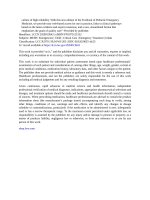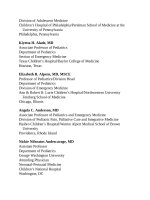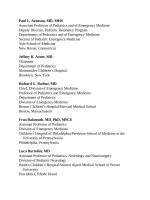Pediatric emergency medicine trisk 2735 2735
Bạn đang xem bản rút gọn của tài liệu. Xem và tải ngay bản đầy đủ của tài liệu tại đây (105.81 KB, 1 trang )
Depression
SIADH, syndrome of inappropriate antidiuretic hormone.
The presentation and management of increased ICP is not unique in pediatric
cancer patients (see Chapter 97 Neurologic Emergencies ). The differential diagnosis
includes tumor (see the “Tumors of the CNS” section) or shunt malfunction more
often than treatment effect. Tretinoin (all transretinoic acid), an agent uniquely used
in the treatment of APML causes increased ICP. Children are particularly sensitive
to this side effect. For patients with severe symptoms attributable to tretinoin, a
diagnostic and therapeutic lumbar puncture may be needed. Opening pressure
should be measured and cerebrospinal fluid should be withdrawn to reduce the
pressure (see Chapter 97 Neurologic Emergencies ).
Children with cancer are at increased risk of seizures from the causes summarized
below and in Table 98.8 . Severe metabolic disturbances can result from SIADH or
from renal tubular wasting of electrolytes (see “Metabolic Complications of Cancer
Treatment” section). Seizures can also be caused by primary brain tumors,
particularly supratentorial, CNS metastasis of solid tumors, or carcinomatous
meningitis. Some chemotherapy agents can cause seizures. New-onset seizures can
be a sign of a bacterial abscess (more likely with Bacillus cereus bacteremia), fungal
abscess, or viral encephalitis such as those caused by herpes simplex virus or CMV.
The approach to seizure management is not unique in patients with cancer and is
addressed in Chapter 97 Neurologic Emergencies . Specific consideration should be
given to assess and correct metabolic and electrolyte abnormalities.
Children with cancer are at increased risk of CVAs. Specific causes in children
with cancer include sagittal sinus thrombosis and intracranial bleeding with
contributing factors of hypertension, coagulopathy, thrombocytopenia, intracranial
tumor, prior surgery, and radiation. Spontaneous intracranial hemorrhage is
extremely rare except when the platelet count is less than 5,000/μL (see
“Hematologic Complications of Cancer Treatment” section). The approach to
diagnosis and management is addressed in Chapter 93 Hematologic Emergencies .
Specific consideration should be given to assess and correct problems with
coagulopathy and/or thrombocytopenia.
Side effects of some supportive-care medications can include extrapyramidal
reactions. Symptoms of such reactions can range from oculogyric crisis with mild
repetitive eye deviation and/or neck motion to severe torticollis and eye deviations.
Reactions can also include tardive dyskinesia (“frozen”) and akathisia
(restlessness/agitation). The key to diagnosis involves a thorough physical
examination and a thorough medication history. Dopamine-receptor antagonists used
as antiemetics are the most common trigger in cancer patients. Such drugs include
high-dose metoclopramide; phenothiazines such as compazine, chlorpromazine









